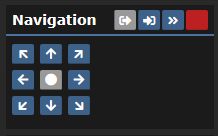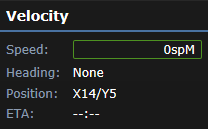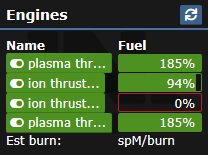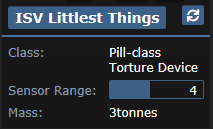Навигационная карта и пилотирование
Дополнительные действия
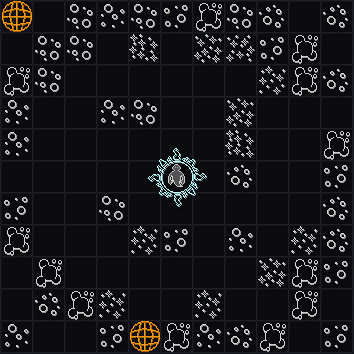
The Overmap is a representation of local space, featuring ships, hazards, and points of interest. This page aims to provide a quick reference to navigating, as well as any hazards and their effects so you can avoid or prepare for them.
Objects
Piloting
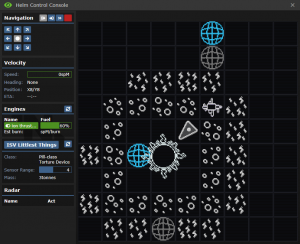
This guide will break down the parts of the helm console display by section, and provide a step-by-step guide at the very end on how to fly like a pro.
Panel Info
Navigation
The bread and butter of flying, this panel accepts commands on which direction to burn the engines in. Pressing the middle circular button will cause the engines to fire in reverse, slowing and/or stopping the vessel.
When inputting commands, remember that your control direction is more nuanced than your travel direction. What that means is that you could be traveling 4spM east, and only have to press south once in order to adjust your bearing to southeast, upon which you will travel perfectly diagonally. From there, you only have to press up once to reset your heading to east. Keep this in mind to conserve fuel as you don't need to adjust too much to get the proper heading. Going diagonally means your ship will travel between two cardinal tiles unaffected! Use this to slip between asteroid fields and other hazards without making a major course change.
The four buttons on the top right (from left to right) are the undock button, the dock in space button, the bluespace jump button, and the AI control button. Docking and undocking are covered in the next section. Bluespace jumping removes your ship (along with everything on it, like people and items) from the round, easing the burden on the server. The AI control button is off by default. When it is on, it turns green. Turning it on lets AIs control the ship.
Docking
Assuming you read the last section, you know where the undocking and docking in space buttons are. The undocking button's purpose is simple; it undocks you from wherever you are and lets you move again. The docking in space button will dock you in empty space. To dock to points of interest, see the radar.
Velocity
This panel shows the speed, heading(direction), position, and ETA to the next tile of the craft. Remember! You only travel in the direction your heading is the moment the ETA timer runs out. If you're moving fast and make a sudden turn at the last second, you'll travel in the direction you turned, rather than the direction you faced during most of your ETA.
Engines
This panel shows the name and fuel level of all the detected engines on the ship. Keep in mind that there is no optimal efficient speed: Your fuel efficiency will be the same no matter what. However, lower speeds are much more forgiving for adjustments fuel-wise. Additionally, You can click the engine’s names to toggle them to strategically save fuel. Your ship will not slow down from drag in empty space, so a high speed can be maintained with little fuel if you're smart about how you use it. If your thrusters are out of fuel, you will suffer passive slowdown to increase your chances of survival!
Ship Info
This panel shows the name, class, sensor range, and mass of your vessel. Click the ship name to rename it.
Radar
 This panel shows all of the objects in docking range of your ship. Hit the button in the “Act” column to interact with an object. As of November 2021, you are now able to dock in empty space tiles. Make use of this for spot repairs, ship modification, and other endeavors you need to dock for, but can't find a planet in order to do so.
This panel shows all of the objects in docking range of your ship. Hit the button in the “Act” column to interact with an object. As of November 2021, you are now able to dock in empty space tiles. Make use of this for spot repairs, ship modification, and other endeavors you need to dock for, but can't find a planet in order to do so.
Piloting Guide
- Ensure your ship is undocked.
- Ensure at least one engine is on and fueled.
- Press the navigational button in the direction you want to fly.
- Repeat until desired speed is reached.
- Press the navigational button again to cease accelerating
- When you get near the destination, press the center button. One press stops any current acceleration, two presses starts braking.
- If you want to dock with the object, go down to the radar tab and hit the “act” button next to the desired docking object.
- You have reached your destination, and are ready to fly anywhere in the solar system!
Advanced Piloting
You've learned the basics. Now it's time for a few tricks to help you stay ahead of the competition.
Advanced Overmap Techniques
The overmap isn't always all it seems. Here's how you can make the best of its little discrepancies (and hidden features!)
- If a ship is hiding itself somehow, as interceptors or pirates are known to, you can locate it easily by right-clicking the tiles on the overmap and looking at the object list. Even if there's no ship sprite on the tile, it's name will pop up in the list. Take that, sneaky bastards!
- The edge of the overmap loops back around in both X and Y. Use it to travel faster, escape from enemy sensors for a moment and hide, or sneak up on someone unsuspecting. Keep in mind it's dangerous to travel quickly across it, as you won't see what's there until you've looped around!
- If you want to be strategic, make an X and Y list of all the planets you come across so you can know where to hide later. It might just come in handy.
Ace Pilot Best Practices
An assortment of other tips that will aid your journey. Did you know... there are three kinds of aces? Those who seek strength. Those who live for pride. And those who can read the tide of battle.
- As long as you're undocked in space, walking into the area outside your ship (hyperspace) will deal incredible brute damage to you, likely killing you. Avoid doing so at any opportunity, or use it to delete items quickly and threaten prisoners.
- Never leave the helm when the ship is in motion, unless you want your ship to explode and your crew to die horribly.
- Setting up your backup generators ahead of time is greatly recommended. Running out of power at the wrong time means you'll likely get shredded by asteroids or worse, especially if you're traveling fast
- Renaming your ship is fun and adds a level of personal touch.
- Never undock without all of your crew accounted for! Due to loading bugs, it can sometimes be impossible to recover crewmates stuck on a planet without admin help. Always issue a warning well before you undock!
- Chasing down other ships is a matter of matching your speed and constantly gauging the area in your scanners. Check the overmap: Where will they run to? Where might they hide? Be a step ahead, always.
- Keep your wideband open, just in case. People tend to use it for emergency distress signals
or idiotic small talk. This is important if you're a rescue ship!
So Your Ship Is Falling Apart...
Uh oh! Did you your pilot fly the ship into an asteroid storm and now you're stuck trying to fix up your ship? Here's what you can do to stay alive!
- Stop the ship. This is your priority. Stopping the ship means you won't fly into more hazards! Ideally, you still have a powered helm and a fueled thruster.
- If you have no power wherever your helm console is, you can move it somewhere else with tools.
- Try to always have some fuel on hand, never spend it all. This helps in emergencies.
- If your helm console or it's circuit are gone, It's pretty much hopeless. Get in a central area and pray for rescue.
- Dock in space and repair your ship as best you can.
- Land at a beach or jungle planet to repressurize your ship. These planets have an Earth-like atmosphere.


